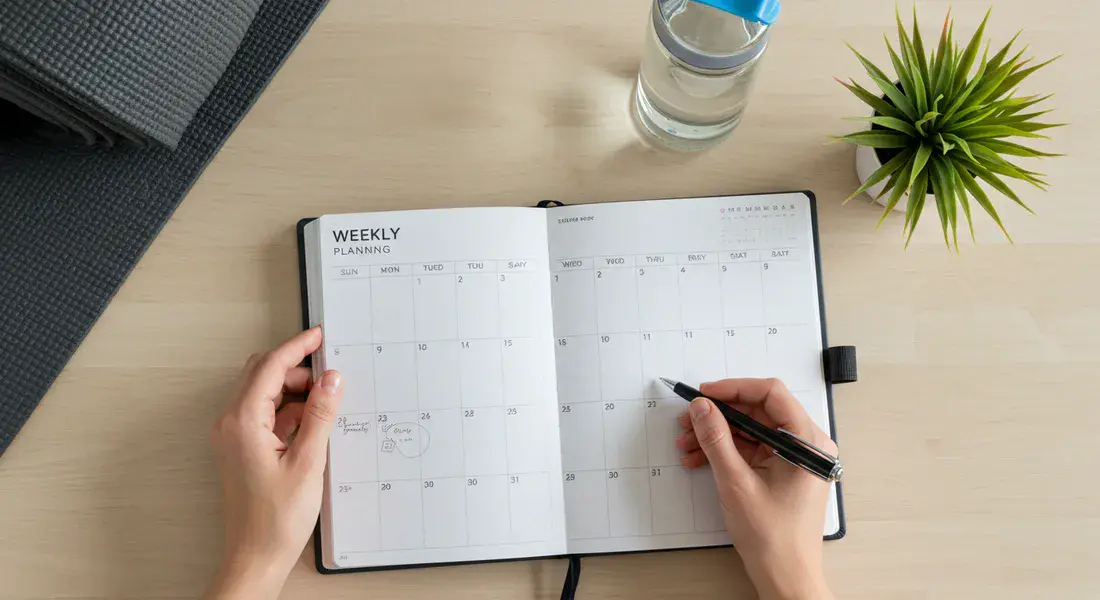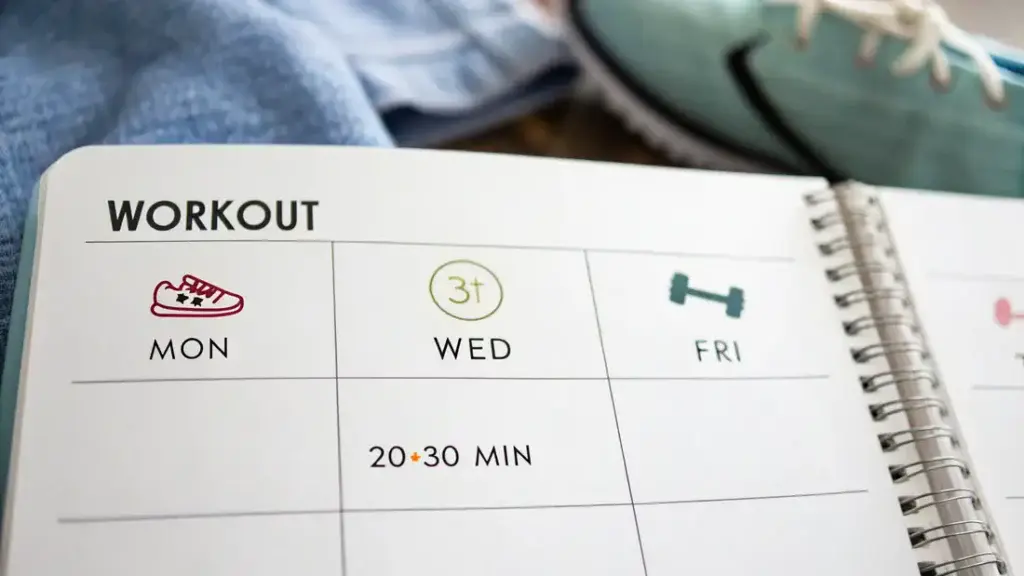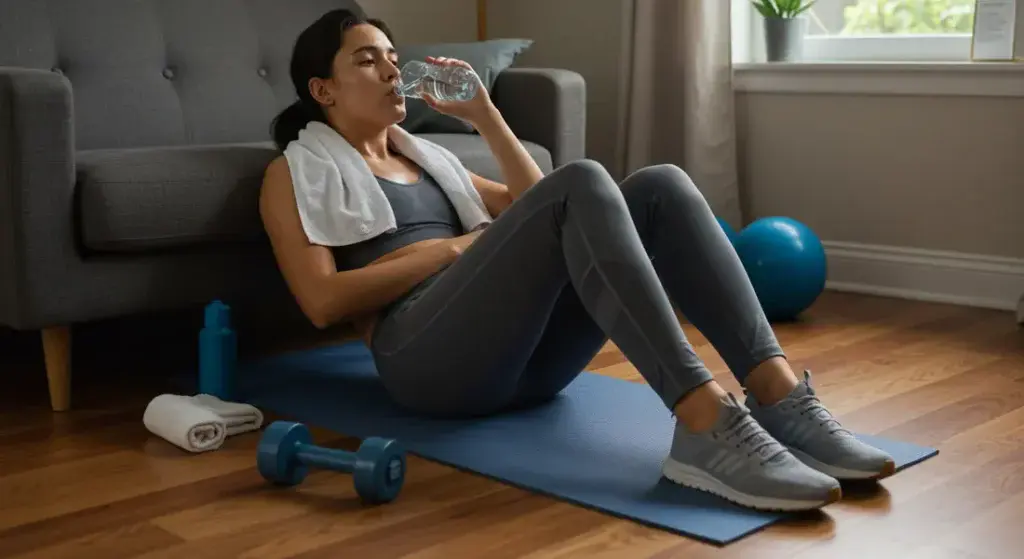Alright, you’re fired up and ready to start exercising at home! You know why it’s beneficial, you’ve set some initial goals, considered your space, and have an idea about essential gear.
But now comes the practical question: “What do I actually do each day or week? How do I structure my time?”

Without a plan, even the best intentions can fizzle out.
Don’t worry, creating a workout schedule isn’t complicated!
This guide provides clear, simple principles and easy-to-use templates specifically designed for beginners building their home fitness routine.
The goal is to create a realistic, sustainable schedule that promotes consistency, prevents burnout, and helps you actually stick with it long enough to see results.
Building your schedule is where everything comes together – it’s how you put your Setting Realistic Fitness Goals for Beginners into action, using the Essential vs. Nice-to-Have Home Fitness Gear you’ve chosen, within your available How Much Space Do You Really Need?.
A good plan also incorporates crucial Basic Home Workout Safety Rules (like warm-ups/cool-downs) and is key for Staying Motivated When Working Out Alone.
Let’s map out your week!
Why Structure Matters – The Benefits of a Schedule
Just “winging it” rarely works long-term. Having a planned schedule offers significant advantages:
- Builds Consistency: It transforms “I should exercise” into “It’s Tuesday, time for my workout.” Scheduling removes the daily decision fatigue and helps solidify exercise as a habit.
- Ensures Balance: A schedule helps you plan for both activity and crucial recovery time, preventing the common beginner mistake of doing too much too soon (overtraining).
- Tracks Progress: Following a schedule makes it much easier to look back and see what you’ve accomplished, plan gradual increases (progression), and stay motivated.
- Manages Time: Allocating specific time slots treats your workouts like important appointments, increasing the likelihood they’ll actually happen amidst a busy life.

Key Questions for Beginners – Frequency, Duration, Time
Let’s tackle the big three scheduling questions:
How Often Should I Work Out? (Frequency)
More isn’t always better, especially when starting. Your body needs time to adapt.
- Start Conservatively: For structured strength/resistance workouts targeting the whole body, aim for 2-3 non-consecutive days per week. This means having at least one rest day between these sessions.
- What About Other Days? Aim for some light activity on your “off” days if you can – a brisk walk, some gentle stretching – but prioritize nailing those 2-3 structured workouts first.
- Listen to Your Body: This is paramount. Begin with 2 days/week. If you feel good and recover well after a couple of weeks, then consider adding a third day. Don’t jump into 5 days a week immediately – that’s a recipe for burnout or injury.
How Long Should My Workouts Be? (Duration)
Forget the idea that you need hour-long gym sessions to see results.
- Quality Over Quantity: For beginners, 20-30 minutes of focused, intentional exercise per workout session is incredibly effective.
- Don’t Forget Warm-Up/Cool-Down: Factor in an extra 5-10 minutes total for these essential components. So, a complete session might be 30-40 minutes door-to-door. (More on why these are vital in our Basic Home Workout Safety Rules guide).
- Short is Still Sweet: Feeling pressed for time? Even a focused 15-20 minute workout is vastly better than doing nothing. Consistency with shorter workouts trumps sporadic long sessions every time.
What’s the Best Time of Day to Exercise?
The fitness world loves debating this, but the real answer is simple:
- The Best Time = The Time You Will Consistently DO It!
- Morning Perks: Some love exercising first thing to get it done before daily chaos ensues, potentially boosting energy for the day.
- Afternoon/Evening Perks: Others feel more physically warmed up later in the day or find it a great way to de-stress after work/school.
- Your Task: Experiment! Try different times and see what fits your schedule and energy levels best. There’s no single “magic” time.

Simple Scheduling Principles for Beginners
Keep these core ideas in mind as you plan:
Start with Total Body Workouts
Instead of splitting workouts by body part (like “Leg Day,” “Arm Day”), beginners benefit most from hitting all major muscle groups in each session.
This is efficient, effective for building foundational strength, and allows adequate recovery time (since you aren’t hammering the same muscles daily).
Focus on compound movements that work multiple muscles at once (think variations of squats, lunges, push-ups, rows, and core exercises like planks).
Prioritize Rest Days – They Are CRUCIAL!
This might be the most underrated aspect of fitness!
Your muscles don’t get stronger during the workout; they repair, rebuild, and adapt during rest.
Skipping rest days increases injury risk and hinders progress.
- What is Rest? It can be complete rest or “active recovery” – light activities like walking, gentle stretching, or using a foam roller (check our Foam Roller guide if applicable) that promote blood flow without stressing the muscles.
- Schedule Them: Treat rest days as non-negotiable appointments in your schedule.

Include Warm-Ups and Cool-Downs (Non-Negotiable!)
Think of these as the essential “bookends” to every workout session.
- Warm-Up (5 mins): Prepares your body for exercise by increasing blood flow and muscle temperature (e.g., light cardio like marching, dynamic stretches like arm circles).
- Cool-Down (5 mins): Helps your body gradually return to its resting state and can improve flexibility (e.g., static stretches holding for 15-30 seconds).
- Safety First: For detailed guidance on how to warm up and cool down properly, please refer to our Basic Home Workout Safety Rules guide.
![Beginner performing a simple arm circle warm-up exercise [or static quad stretch cool-down] at home](https://reliablehomefitness.com/wp-content/uploads/2025/04/beginner-workout-warmup-or-cooldown-stretch-1024x559.webp)
Be Flexible – Life Happens!
You will miss a workout occasionally. It’s inevitable. Don’t let it throw you completely off track or lead to guilt.
- The Strategy: Simply aim to get back on track with your next scheduled workout. Avoid the temptation to cram two workouts into one day to “make up” for it – this can lead to overexertion. Consistency over the long haul is what matters, not perfection week-to-week.
Sample Beginner Weekly Templates (Adaptable!)
Use these as starting points and adjust the days to fit your life:
Template 1: The 2-Day Starter (Focus: Building the Habit)
- Monday: Rest / Active Recovery (e.g., Walk)
- Tuesday: Total Body Workout (20-30 mins + WU/CD)
- Wednesday: Rest / Active Recovery
- Thursday: Rest / Active Recovery
- Friday: Total Body Workout (20-30 mins + WU/CD)
- Saturday: Rest / Active Recovery
- Sunday: Rest
Template 2: The 3-Day Standard (A Common & Effective Goal)
- Monday: Total Body Workout (20-30 mins + WU/CD)
- Tuesday: Rest / Active Recovery
- Wednesday: Total Body Workout (20-30 mins + WU/CD)
- Thursday: Rest / Active Recovery
- Friday: Total Body Workout (20-30 mins + WU/CD)
- Saturday: Rest / Active Recovery
- Sunday: Rest
(Remember: WU = Warm-Up, CD = Cool-Down. Active Recovery is optional but beneficial).
Listening to Your Body – The Most Important Rule
This schedule is a blueprint, not unbreakable law. Your body provides constant feedback – learn to listen!
- Pay attention to unusual fatigue, prolonged or excessive soreness (understand difference between normal DOMS and sharp pain), and your overall energy levels.
- Never push through sharp, sudden, or radiating pain. Consult our Basic Home Workout Safety Rules guide and potentially seek professional advice.
- It is absolutely okay (and often smart) to take an extra rest day if you feel genuinely run down or overly sore.
Your Beginner Workout Schedule – Simplified:
- Frequency: Start with 2-3 non-consecutive workout days per week.
- Duration: Aim for 20-30 minutes of focused exercise per session.
- Essentials: ALWAYS include a 5-min Warm-Up and 5-min Cool-Down (See Safety Guide).
- Structure: Focus on Total Body workouts initially.
- Rest is Key: Schedule dedicated rest days – they are crucial for results!
- Be Flexible: Don’t aim for perfection; aim for consistency over time.
- Listen Up! Pay attention to your body’s signals (fatigue, pain, energy).
Conclusion – Your Personalized Plan Awaits
You now have the core principles and simple templates needed to move from “I want to work out” to having an actual, actionable plan.
Building a schedule provides the structure necessary for turning intention into a sustainable habit.
Your action step: Take 5-10 minutes right now. Look at the templates, consider your personal commitments and energy levels, and pencil out your workout and rest days for the upcoming week. Write it down!
Remember to start slowly, prioritize consistency over intensity, and don’t hesitate to adjust your schedule as you learn what works best for you.
Building fitness is a marathon, not a sprint.
With your schedule drafted, you might be thinking about how to stick with it or want a refresher on safe practices.
Head back to the main Beginners Guide to Starting Home Fitness and explore these vital companions to your schedule:
- Staying Motivated When Working Out Alone
- Basic Home Workout Safety Rules (Essential reading!)
You’ve got a plan – now it’s time to put it into motion!
References & Further Reading
- WHO Guidelines on Physical Activity and Sedentary Behaviour. Geneva: World Health Organization; 2020. RECOMMENDATIONS.
Note: This information is for general knowledge and informational purposes only, and does not constitute medical advice. Always consult with a qualified healthcare professional before beginning any new fitness program or making any changes to your healthcare routine.
